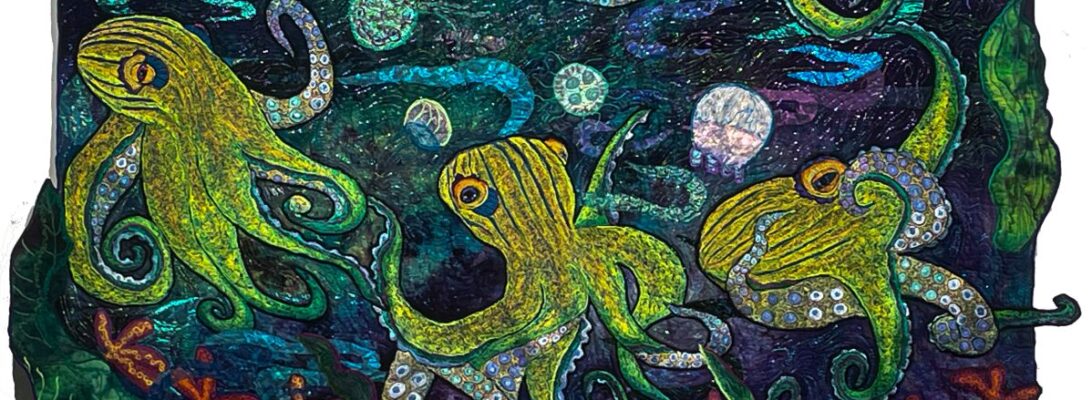
We talked earlier about soft edge applique. Soft edge is a minimal treatment that simply covers the edge of an applique with monofilament nylon or poly thread with a zigzag stitch. For things like water, air, fire, rocks, mist, suns and moons it’s perfect. Sometimes it’s good for flower petals as well. It’s for anything that doesn’t need a hard defining edge. It creates soft color shifts across the quilt.
But some things need that edge. Bugs, birds, frogs and fish all need that hard definition. Or you can’t really see them at a distance. And it makes a huge difference when you go to photo your piece.
You know I’m a color girl. I’m going to want to use color every time I can. But over the years I have learned, if you want it to stand out, use the black for an outline.


I particularly have tried it with bugs. Metallic thread green thread always gets my attention, and I reach for it much in the way you might reach for cherry cordial chocolates. But I’m mildly disappointed with it in the end, because it never gives as defined a space.

I’ve been working on this egret, and the my process shots reminded me how important that outline is. Again, I’ve been working on doing a dimensional white bird, so it has a lot of contrast underneath to shade to white on the top.
The bare bones outline define the areas to shade with color. I’ve come to rely on 40 weight Madeira Poly neon. It comes in several blacks, but the definitive one is color #1800. I’m using a free motion zigzag stitch to outline, which is why the width is variable. (See post Zigging Upended for a tutorial on zigzag stitch).
I build color, from dark to light from the outline. For more information about choosing those colors, check out this post: Into White: The Search for White Thread Painting. But it’s coloring within the lines. As you can guess, I’m not so good at that. The threads encroach over the line and things get mushy. So the final act is that reoutline.
You can see the difference that second outline makes. All the edges that are fuzzed and mussy are now tightened up and out there.

The outside edges will be defined as I stitch the bird down. But having the inner edges cleaned with an extra edge of stitchery redefines all the lines.
When I applique the bird on, again I’ll use my zigzag stitch with black thread. It gives the outline definition and punch and helps separate the bird from the background.




































































































